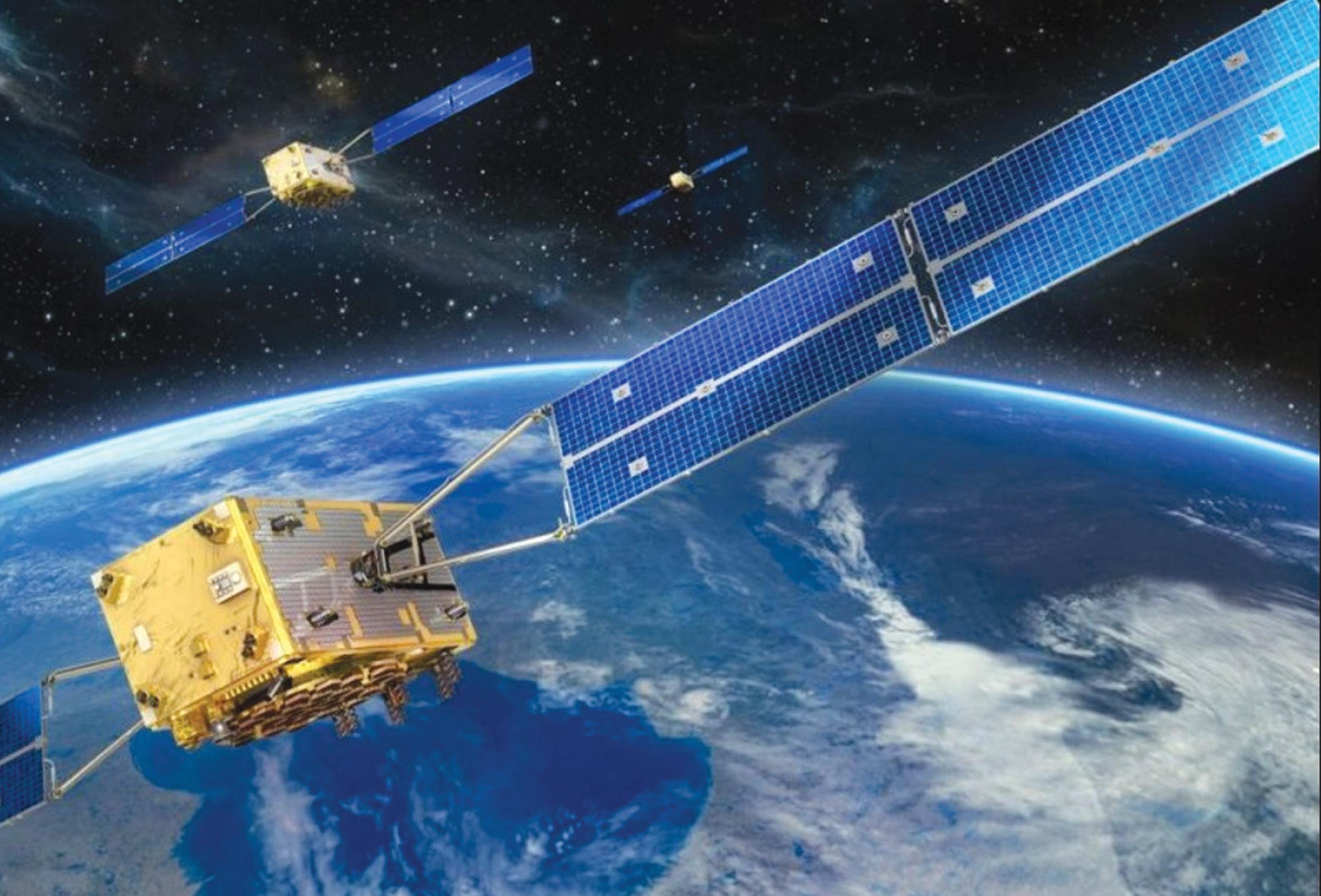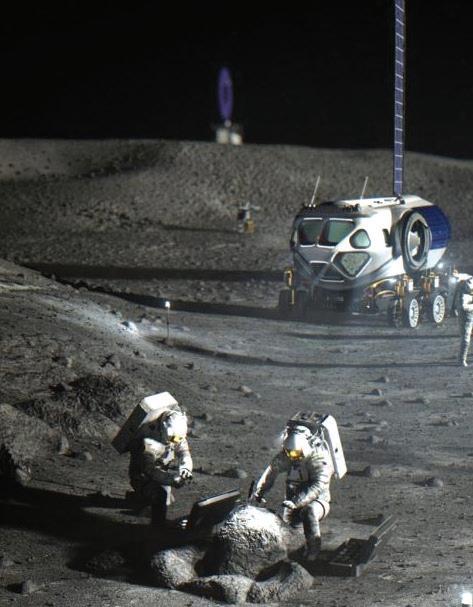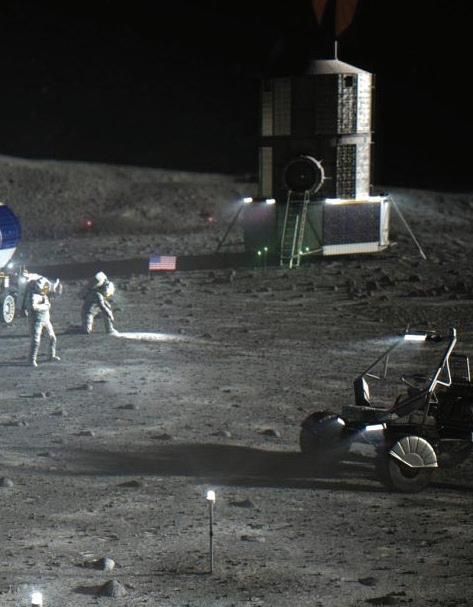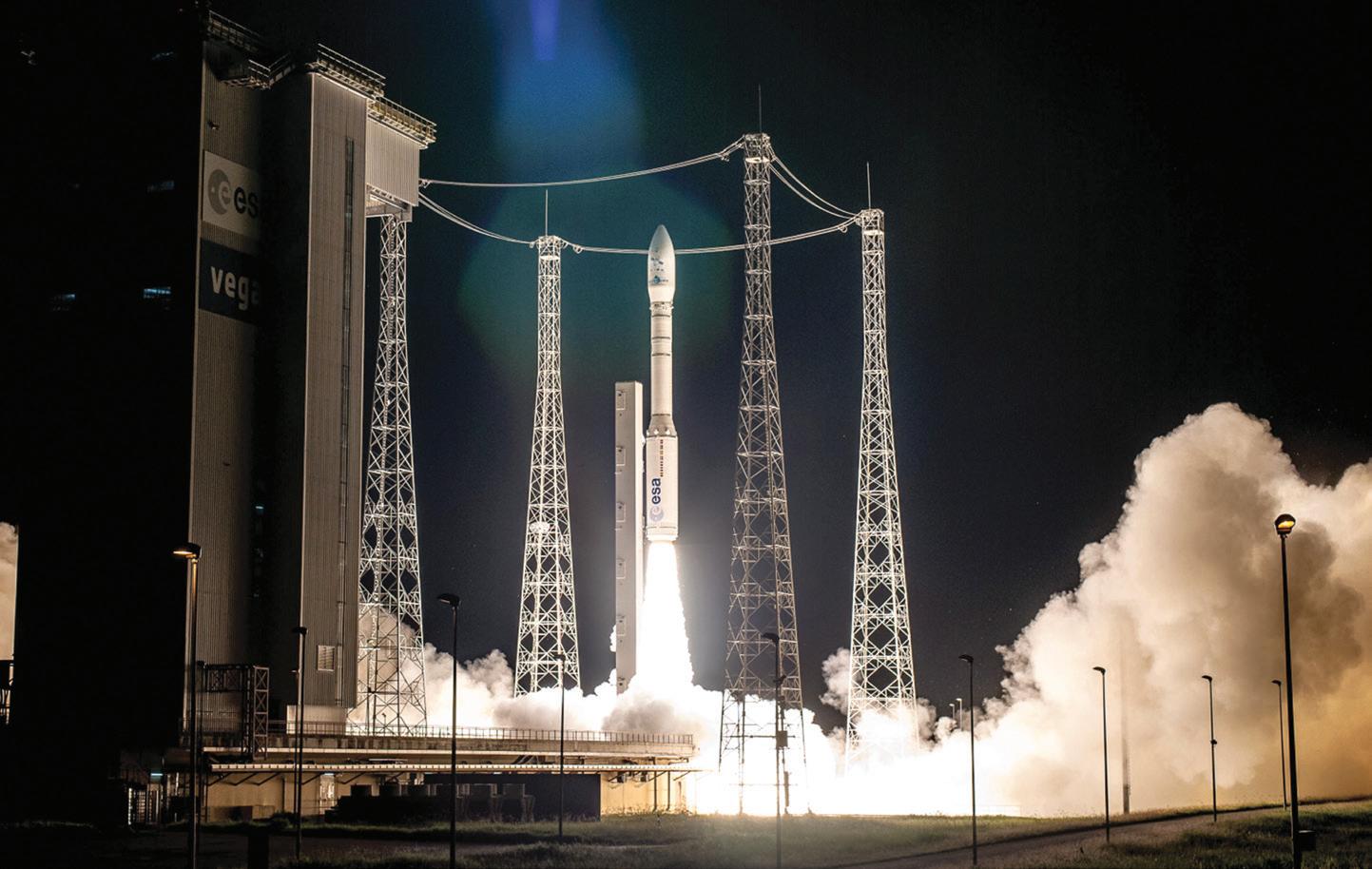
10 minute read
Space Europe what the future holds
Space is undoubtedly going through a period of profound change. The war in Ukraine has brought to an end many cooperation activities between the Western countries and Russia but many projects with other partners have started. In a scenario where private companies have entered the sector, the New Space Economy is a fact and the Lunar Economy is soon to come, Space has become the next frontier of economic development. Opportunities that were unthinkable just a few years ago have triggered a race against time in fields such as quantum technologies-based telecommunications, satellite navigation and cybersecurity. And in the meantime, new players are joining the international community. India is getting ready to fly its first astronaut, while China is building its new space station. Everyone wants to be ready to get a piece of the cake of what has been called 'the fifth industrial revolution'.
by Enrica Battifoglia
The impact of war
The most tangible change in the world of cooperation took place when Russia invaded Ukraine in February 2022. The European Space Agency (ESA), with its 22 Member States and many Western companies, decided to sever relations with Roscosmos, the Russian Federation's space corporation. The result was a knock-on effect with vast implications for all space programs.
ESA's ExoMars mission, a joint project with Russia originally scheduled to launch a robotic rover in 2022, was halted because of the Russian aggression against Ukraine on Feb. 24, 2022 and delayed by 6 years. The Rosalind Franklin rover is meant to search for evidence of life two meters into the Martian surface with a drill designed and manufactured in Italy. New technologies are now necessary to replace the elements originally provided by Roscomos on board the rover. The next launch opportunity is currently scheduled for 2028. NASA has provided an element for the rover. ESA has entrusted the Italian industry and in particular Thales Alenia Space Italia (Thales 67%, Leonardo 33%), with leading both missions, as well as with the responsibility for all the elements and the entire ro-
Galileo satellites now in orbit are designed to deliver a better satellite navigation signal for the EU.

Credits: ESA ver system. The vehicle carries a drill made by Leonardo and designed to penetrate the Martian surface to a depth of 2 meters in order to collect samples in search for signs of past or present life. Italy is also in charge of the ROCC - Rover Operation Control Centre - manufactured by Altec (Aerospace Logistics Technology Engineering), owned by Thales Alenia Space Italia (63.75%) and Asi (36.25%). The ROCC will control the surface mission.
With Mars still very much at center-stage, the European Space Agency is working with NASA on the proposed Mars Sample Return mission - MSR - designed to return soil and rock samples from the surface of Mars back to Earth for the first time in history.
The Soyuz launch campaign from Europe’s Spaceport in Kourou that included four European missions has been suspended and the Euclid space telescope will be launched on SpaceX Falcon 9 from the Kennedy Space Center at Cape Canaveral in July next. Italy plays an important role through its Space Agency ASI, the National Institute of Astrophysics (INAF), the National Institute of Nuclear Physics (INFN), many universities (including Bologna University, Ferrara University, UNIMI, Rome La Sapienza, Roma Tre, University of Trieste, Sissa and Cisas). Together with INAF and INFN, ASI also leads a Temporary Joint Venture that has provided the instruments, with Ohb Italia as agent, Sab Aerospace and Temis as principals. At the European level, Thales Alenia Space Italia is prime contractor for the construction of the satellite. Both the EarthCARE mission for Earth observation and the first two new-generation satellites of the European navigation program, Galileo M10 and Galileo M11, need a new launcher. The same applies to the HERA probe that is to travel to Dimorphos, a small asteroid whose trajectory was deflected on September 27, 2022 by NASA's DART probe which crashed into it marking the world's first attempt at testing a planetary defense strategy that could protect the Earth against incoming asteroids. HERA will have to examine and measure the crater DART generated upon smashing into the asteroid. It is scheduled to launch in 2024 on board of either the new European launcher Ariane 6, or on a Falcon 9. ASI has contributed to the DART mission by supplying the nano-satellite LiciaCube, a unique cosmic photoreporter that has made it possible to collect valuable images and data. LiciaCube, a veritable concentration of new technologies, starting with Artificial Intelligence, is managed and coordinated by the Italian Space Agency and built by Argotec, and can count on the scientific cooperation of INAF, Milan Polytechnic, the University of Bologna, the Parthenope University of Naples and the 'Nello Carrara' Applied Physics Institute of the National Research Council (CNR-Ifac).
The Moon - the new frontier
Old alliances are broken and new ones are born and the Moon is no exception to it. Luna-25, Luna-26 and Luna-27 missions, for example, are now waiting for a new rocket their Europe-Russia joint endeavor is no longer. The Esa Pilot-D navigation camera, originally planned for Luna-25, will be tested on a commercial flight while for Luna 27, the implementation of Prospect, a package containing a robotic drill and a miniature lab, will be redirected towards flight on a NASA CLPS -Commercial Lunar Payload Services - mission. A suitable flight opportunity also will be found for PILOT, a full-fledged version of the precision landing and risk prevention technology, originally planned for Luna 27 and necessary for European lunar exploration activities, such as the European Large Logistic Lander (El3). ESA’s EMS-L, the Exospheric Mass Spectrometer instrument, will fly on board the JAXA/ISRO LUPEX lunar rover mission.
The Moon has become the new frontier of space exploration, especially thanks to the Artemis mission launched by NASA with a view to landing the first woman and the next man on the moon. It is a field where many partnerships have been signed with public institutions and private companies. At least 80 new public or private projects are expected to be launched in the next few years to promote lunar
Lunar outpost.
Credits: NASA exploration and utilization activities. The European Space Agency and the Italian Space Agency are leading the way.
The signing of the Artemis Accords, the multilateral agreements establishing the general principles for future lunar missions, has marked Italy's first step in this direction. Canada, the United Kingdom, Luxembourg, Japan, the United Arab Emirates, Australia, and the United States have followed suit. Going back to the moon is no longer enough and it’s a fact: the goal is to stay and to build structures that will make it possible to explore more of the lunar surface and utilize its resources to take the next giant leap and send missions to Mars.
This is why work is being done on the satnav coverage and communication links to the Moon by implementing ESA's Moonlight initiative designed to support future institutional and commercial missions.
The idea is to launch a Lunar Economy and in this project Italy and its industrial sector play an im- portant role. Telespazio (Leonardo-Thales) heads a consortium whose members are satellite operators such as Inmarsat and Hispasat, major companies such as Thales Alenia Space, Ohb and Mda Uk, SMEs and start-ups such as Argotec, Altec and Nanoracks Europe alongside universities and research centers such as See Lab Sda Bocconi and Milan Polytechnic. Argonaut is another important European project. It is the name given to the ESA's El3, the European Large Logistic Lander, which is meant to deliver materials, supplies, and infrastructure to astronauts on the lunar surface.

Meanwhile, the British company Sstl is building the first telecommunications satellite, the Lunar Pathfinder, designed to operate in a lunar orbit, which Nasa will launch in exchange for communication services.
The future of lunar exploration also goes through the selection of crews. The first European astronaut is expected to fly with the Artemis 4 mission, that is he or she will be part of the second crew that will set foot on the moon. A second European astronaut is scheduled to take part in the Artemis 5 mission while a third colleague will have a reserved seat on a mission still to be identified. ESA has given Italy a formal commitment that either Samantha Cristoforetti or Luca Parmitano, two astronauts of the 2009 class, will be able to fly to the Lunar Gateway between 2025 and 2030.

Europe keeps a united front
Europe, a significant space power, has made a call to unite in order to face up to such drastic changes as proven by the nearly 17-billion-euro budget that was pledged for ESA at the ESA Council at Ministerial level in Paris in November 2022: it is a marked increase if compared to the previous budgets of 10.3 billion euros in 2016 and 14.5 billion euros in 2019 respectively.
The decision on a new budget was all the more remarkable especially considering that it was agreed on despite the ongoing war, the energy crisis, and the Covid-19 pandemic. It's a trend that all Member States are following starting with Germany, which increased its contribution to space programs from 3.2 billion euros in 2019 t3.5 billion euros in 2022, equaling 20.8% of all of the contributions by ESA Member Countries. France is standing close, up to 3.2 billion euros from 2.6 billion euros, or 18.9%, and Italy has gone from 2.2 billion euros in 2019 to 3.08 billion euros or 18.2%. Italy has allocated considerable resources to Space, earmarking a total of 23 billion euros as envisaged in the National Recovery and Resilience Plan (NRPR).
Also at the 2022 ESA Council at Ministerial level, ESA greenlighted new projects for the Moon, such as Argonaut, and continued to finance its flagship activities, such as Earth observation, allocating 2.7 billion euros out of the three initially planned. The enormous amount of data delivered by the European satellite constellations, in particular by the Sentinels of the Copernicus program headed by the European Commission (EC) in partnership with the European Space Agency (ESA) with Sentinel-1 Next Generation and Sentinel-3 Next Generation, will soon benefit Earth observation activities. The European Space Agency has got on its agenda also the NGGM (NextGeneration Gravity Mission) and MAGIC mission, which will study the Earth's gravity, oceanic circulation patterns, and watercourses, and the Aeolus-2 mission, designed to improve operational weather forecasts, thanks also to an instrument built in Italy. Aeolus 2 is developed in cooperation with the European Organization for the Exploitation of Meteorological Satellites, Eumetsat.
Satellite navigation is another strong feature of Europe further enhanced by the coming of Galileo Second Generation (G2).
New Space Economy
The New Space Economy, or New Space, which started out in the United States when private companies got involved in the Space sector, has brought about major changes. Europe has started to get organized and has become aware that the time to act is now if it is true that thanks to the New Space, as the most recent estimates seem to indicate, the global Space turnover could more than double by 2040, reaching a $1 trillion from the current $350 billion.
The private sector has become a major player in the manufacturing of both launchers and satellites, so much so that, according to ESA's estimates, 'in this decade, the total number of satellites launched each year will be four times that of the 2010s'. Just think of the giant constellations of satellites for the global Internet, such as Starlink and OneWeb, soon to be joined by Amazon's Kuiper project. The company recently got the go-ahead to build a 3,236-satellite constellation for broadband Internet connection to be launched by 2029.
The ESA AGENDA 2025, the document outlining the challenges to maintaining and growing Europe’s role in the space economy, auspicates that Europe will fully benefit from Space. The growing importance of Space applications in everyday life, from the environment and agriculture to transport and civil protection, is evident, and with this in mind, it is essential to strengthening relations between the European Space Agency and the European Union.
The first step in this direction dates back to the 2004 framework agreement, which was followed in 2009 by the Lisbon Treaty that gave the European Union a specific Space competence. Therefore, it is important to promote a stronger cooperation between the European Space Agency and other European organizations engaged in Space activities, such as Eumetsat, the European Union Satellite Centre (SatCen), the European Defence Agency (EDA), the European Maritime Safety Agency (EMSA), the European Centre for Medium-term Weather Forecasts (Cepmmt), and the European Environment Agency (EEAA).
It is equally important to retain expertise in areas that have long been ESA's strengths in space applications, such as telecommunications, satellite navigation, cybersecurity and Earth observation. These sectors could be heavily impacted by quantum technologies-driven innovations that are advancing at a rapid pace in Europe also thanks to the establishment of the first quantum computer network in Germany, France, Italy, Poland, the Czech Republic, and Spain. The initiative is part of EuroQci, one of the pillars of the new EU Secure Connectivty Program to secure satellite telecommunications deploying Iris2, in which the European Space Agency is a player. More about it in our next article.
Access to Space
A prerequisite for all Space activities is access to Space. Following the termination of the Russian Soyuz launch operations, Europe is reorganizing also its Kourou base to be able to meet the growing demand for launches. ESA has entrusted SpaceX with the launch of a number of missions, in anticipation of the new European launchers to which is looking forward with great expectations: Vega-C, soon going back to safe launches after the rocket's failure last December, and the new Ariane 6 heavy-lift launcher. In the meantime, alliances were struck within the European Agency at the ESA Council Meeting at Ministerial Level held in Paris on 22-23 November 2022. Italy, Germany, and France concurred on the need to review the public funding necessary to equilibrate the Ariane 6 and Vega-C institutional and commercial exploitation so as to guarantee a substantial return to the Italian sector.
Future projects include Space Rider, the first reusable transportation system designed to provide Europe with a system for routine access and return from low orbit. It's been strongly supported by ASI. The project is the result of an agreement signed between ESA, Thales Alenia Space, and the European Launch Vehicle consortium formed by Avio and ASI. Mentioned must be made also of the important role played by the Italian Aerospace Research Centre (Cira). Space Rider may be deployed by the Vega-C light launcher. Once in orbit, the European small uncrewed robotic laboratory the size of two minivans could allow for microgravity experiments to be carried out inside its cargo bay.
The great dream of the future is securing Europe an autonomous access to Space also for manned missions. This is also called for in the European Astronaut Manifesto, which emphasizes how crucial it is to develop launchers suitable for carrying spacecraft with astronauts on board.











